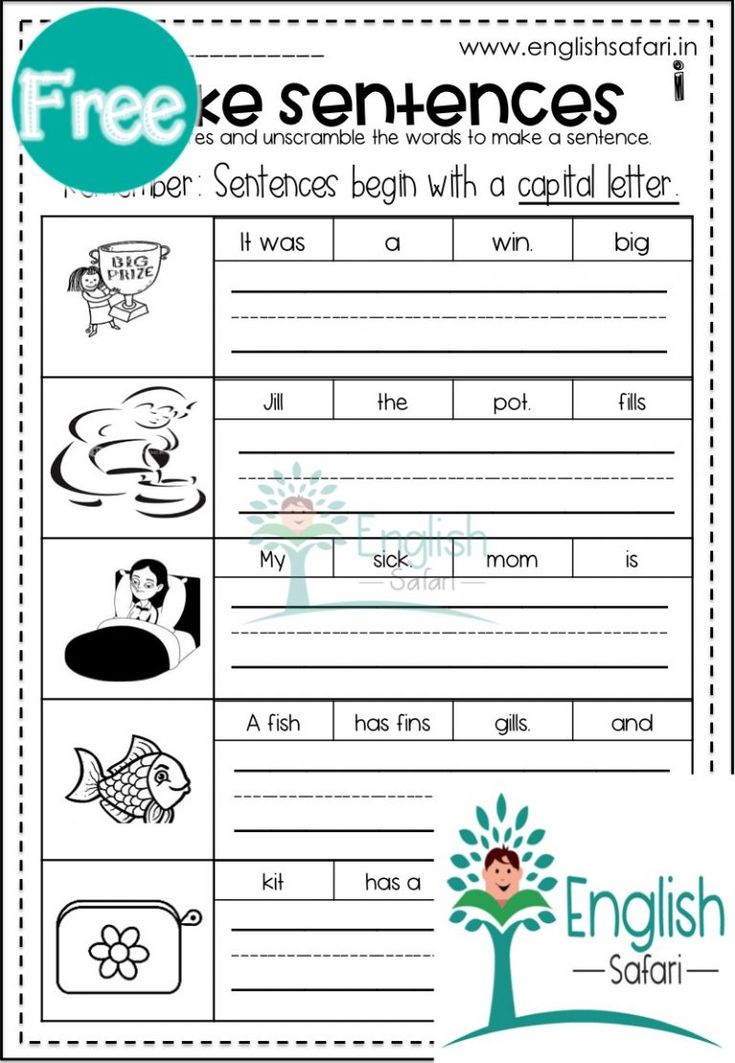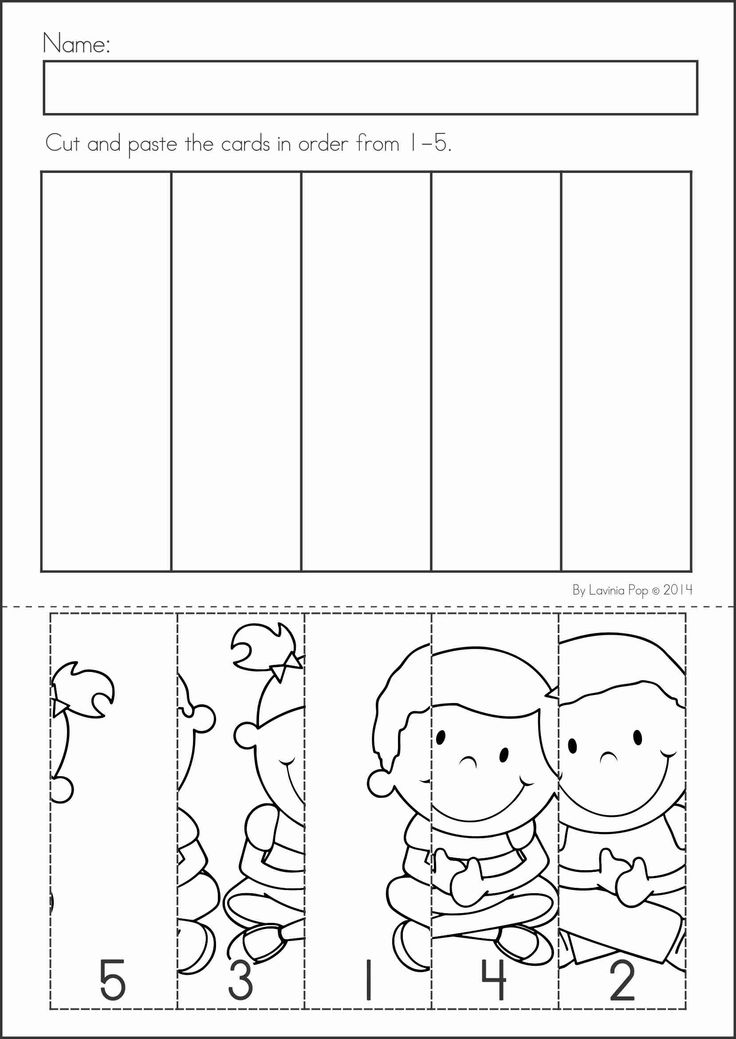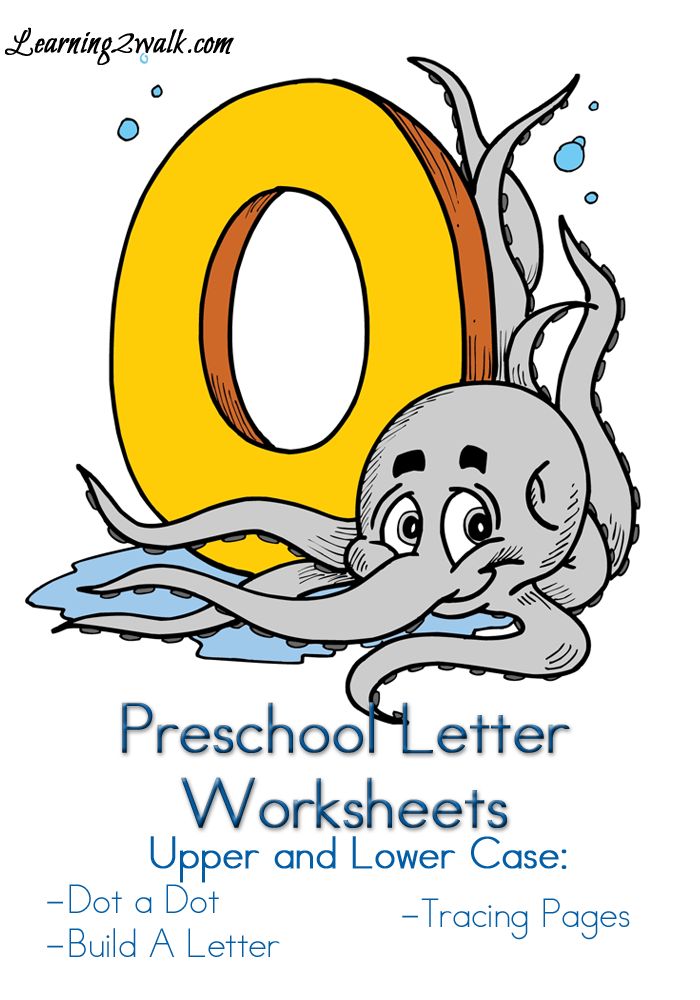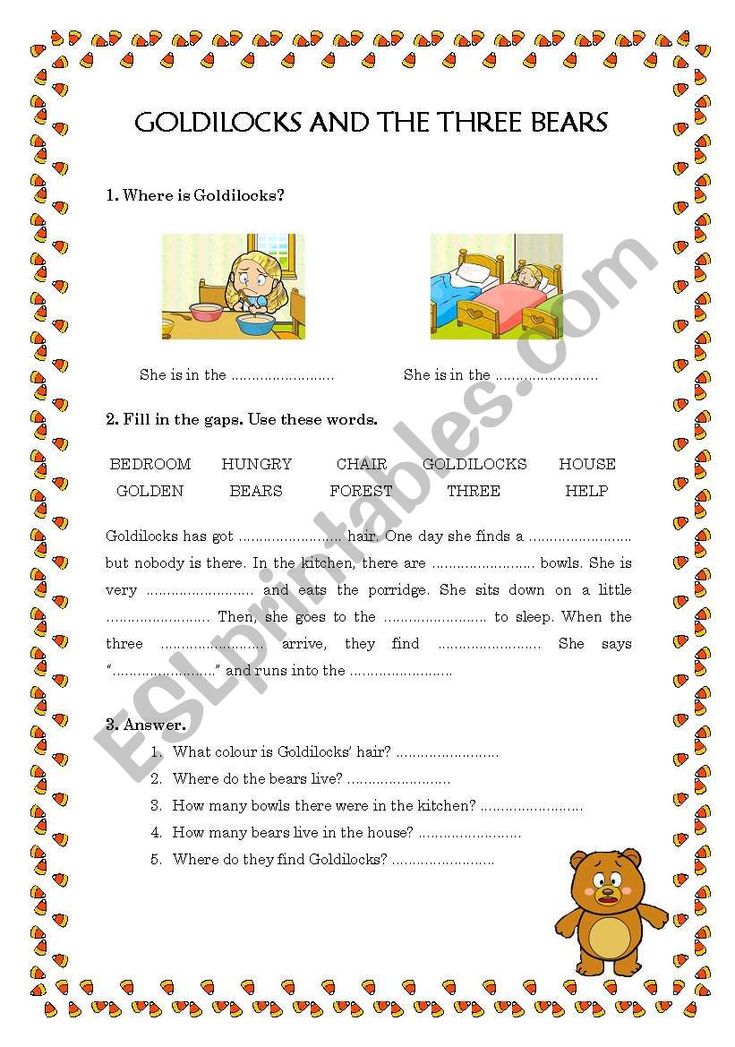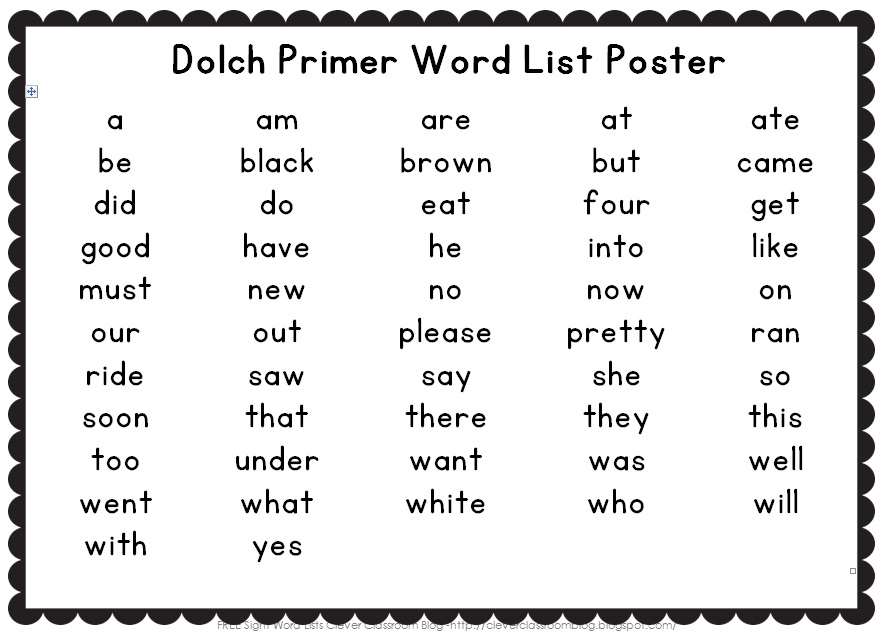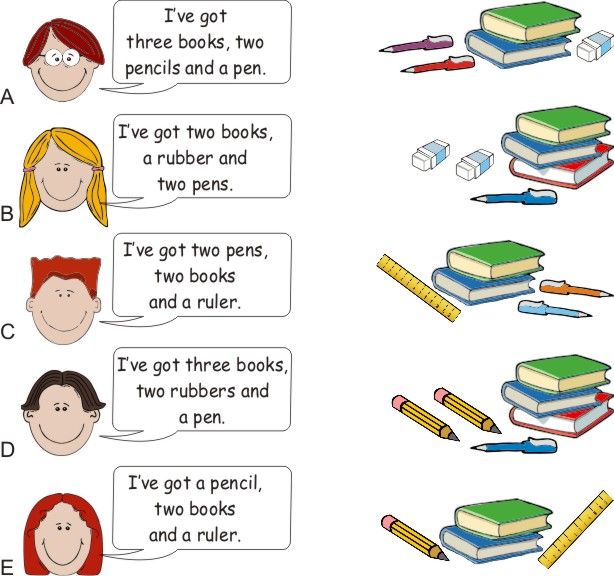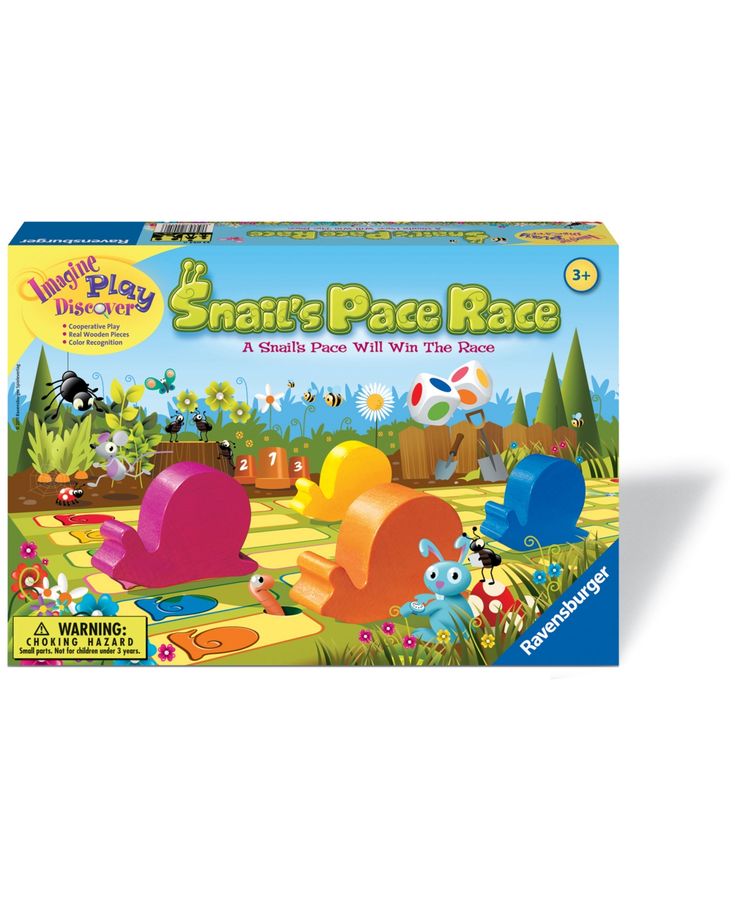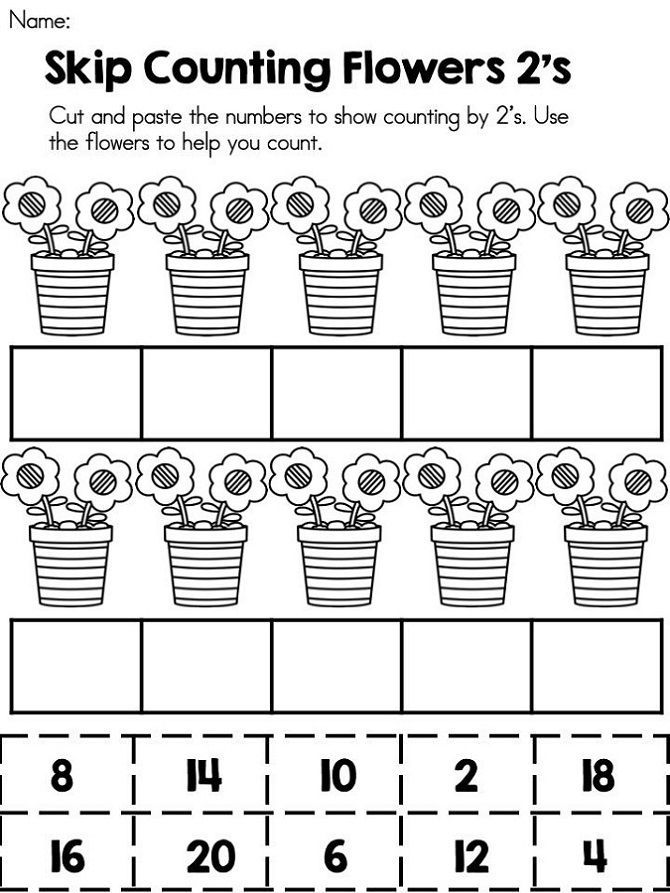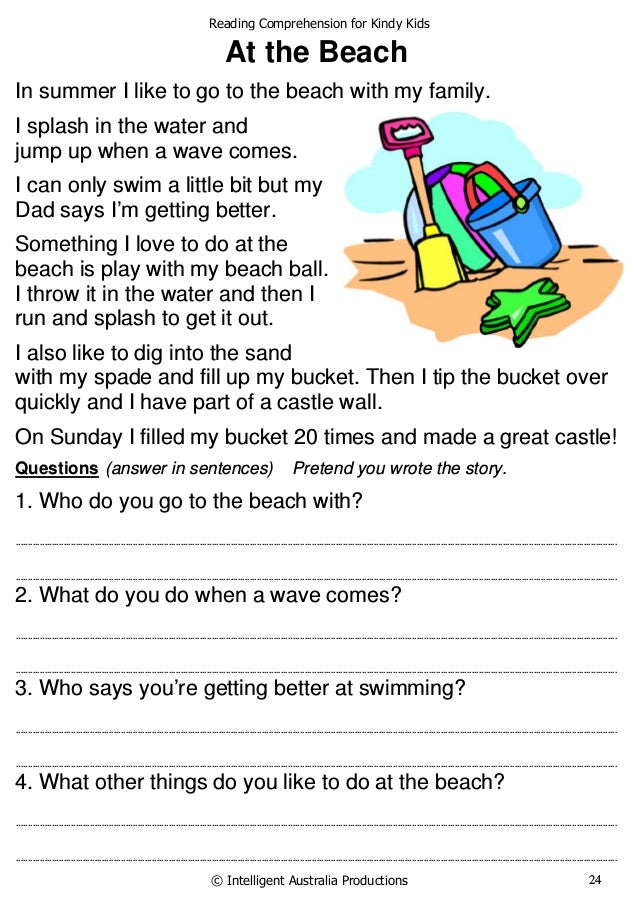Vocabulary at home
50+ English House Vocabulary Words: From the Bedroom to the Kitchen and Beyond
By Elisabeth Cook Last updated:
Your home is made up of so many things. How can you start naming them all?
Learning the English words for all the different rooms and items in your house is a challenge.
But getting started is easy!
Below, we’ll look at basic vocabulary for talking about your house and the things in it.
Contents
- 50+ Must-Know English House Vocabulary Words
-
- English Vocabulary for the Different Parts of a House
- English Bathroom Vocabulary
-
- Bathroom Furniture and Fixtures
- Bathroom Items
- English Bedroom Vocabulary
-
- Bedroom Furniture and Fixtures
- Bedroom Items
- English Den or Living Room Vocabulary
-
- Den or Living Room Furniture and Fixtures
- Den or Living Room Items
- English Dining Room Vocabulary
-
- Dining Room Furniture and Fixtures
- Dining Room Items
- English Kitchen Vocabulary
-
- Kitchen Furniture and Fixtures
- Kitchen Items
Download: This blog post is available as a convenient and portable PDF that you can take anywhere. Click here to get a copy. (Download)
50+ Must-Know English House Vocabulary Words
English Vocabulary for the Different Parts of a House
First, let’s look at some of the main rooms and parts of a house.
Rooms and houses can be a little different depending on where you live. These are parts of a typical American house that you’ll also find in a lot of other places.
Attic — A room at the highest part of a house, below the roof (see below).
Bathroom — Any room with a toilet and sink.
It’s weird, but not all bathrooms have a place where you can take a bath! A bathroom might also be called a restroom or washroom.
Basement — A level below the ground level of a house.
The basement is the whole underground space. It might be one big room or a group of smaller rooms.
Bedroom — Where the bed is, of course!
In a lot of houses, bedrooms are upstairs (on a level above the ground floor).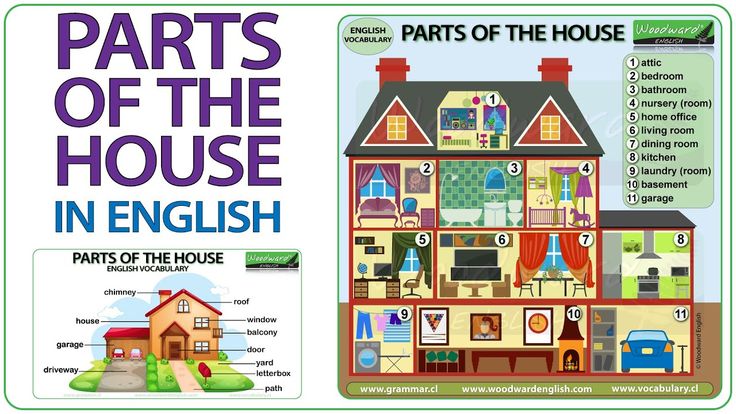
Den — A room with comfortable furniture for relaxing.
A den is like a living room (see below), but less fancy and more private.
Dining room — The room where meals are eaten.
Driveway — The short “road” next to a house where you can park a car or drive it into the garage.
Garage — The building where you keep a car.
You can use the word garage whether or not this building connects to the house.
Hall — A hall or hallway is the narrow (small, thin) space that connects rooms.
Kitchen — The room where you store and prepare food.
Living room — A living room is a room for relaxing or entertaining guests.
In English-speaking countries, this room is often located toward the front of the house. In the U.K., it’s sometimes called the sitting room.
Porch — A covered outdoor space.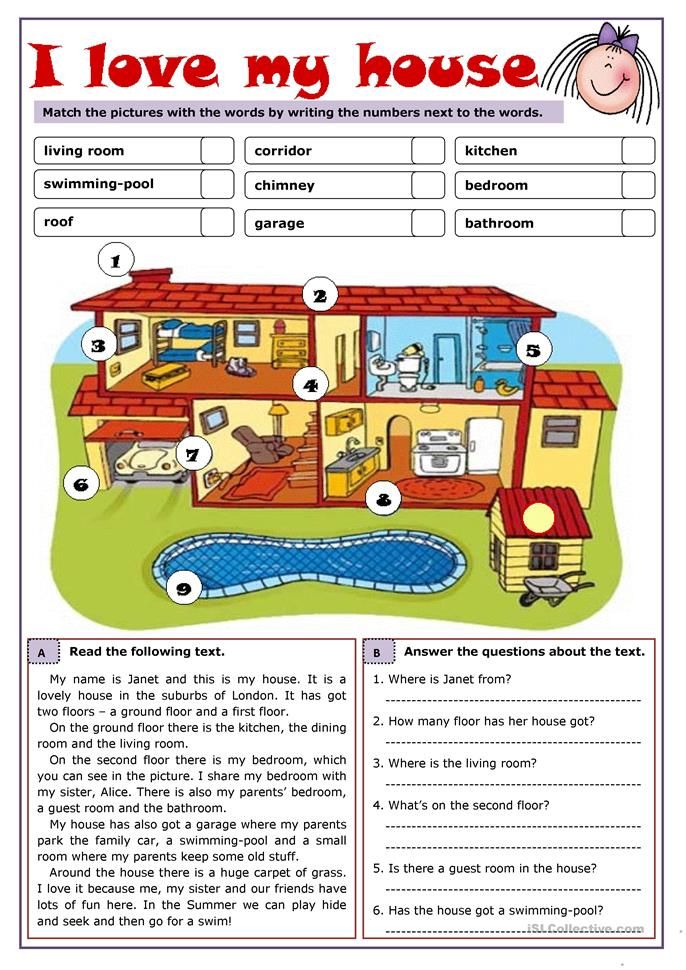
A porch can be at the front, back or side of a house.
Sometimes porches will be less like open spaces and more like rooms with lots of screened windows (that let air in but keep bugs out!).
Roof — The covering on the top of a house.
Roofs come in different shapes and styles, but the most common kind in the U.S. and the U.K. (and a lot of other places) is a gable roof. A gable roof has two flat surfaces that tilt up and come together, making a triangle. The space under the roof in this triangle area is usually where the attic is.
Stairs/stairway — The set of steps that connect different levels of a house.
Yard — The outdoor area at the front, back or side of a house.
In the U.K., people call a yard a garden. In the U.S., a garden is a part of a yard for growing plants, like flowers or vegetables.
As you can see, many parts of the house have two different names. For example, a yard can be a garden.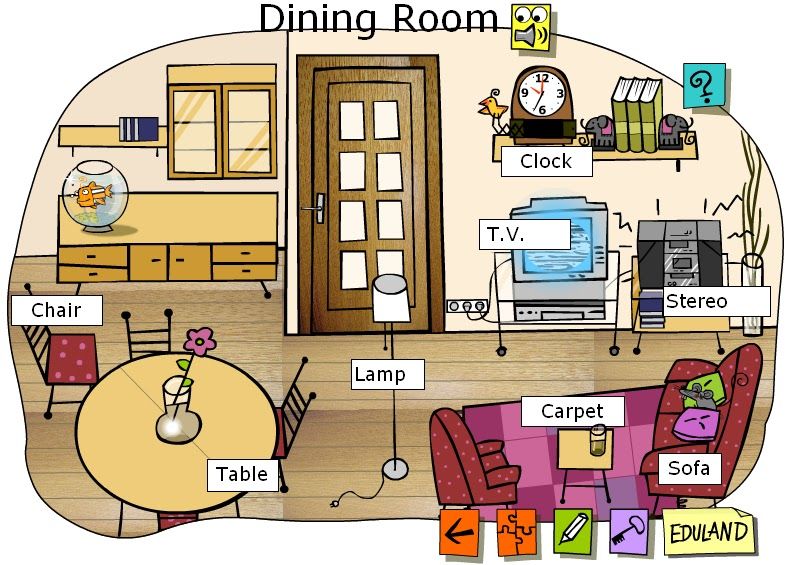 A living room can be a den.
A living room can be a den.
English Bathroom Vocabulary
Now that we know what the different parts of a house are, let’s look at some furniture and objects you might find in the most common rooms of a house.
Bathroom Furniture and Fixtures
By the way, furniture usually means bigger objects around a house that you might sit on, lie on or put things on.
But in some rooms, like the bathroom, the furniture you find might be more like a part of the room (something attached to the wall or floor). A piece of furniture like this is called a fixture.
Bathtub — The large container you fill with water to take a bath.
Most bathtubs have a faucet or tap (where water comes out) and a shower head that sprays water from above.
Counter — Almost any raised, fixed surface that you use while standing.
Since you usually find counters in kitchens and bathrooms, they’re made of material that’s easy to clean.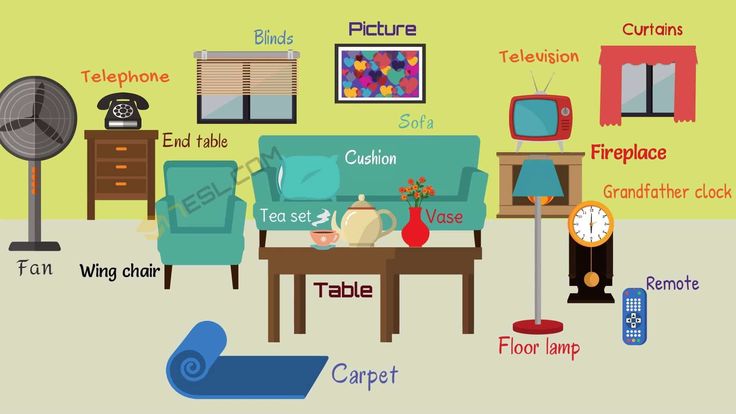
Mirror — The glass surface where you can see yourself (your reflection).
Shower — A shower stall, or a small room where you can shower.
Shower can mean a shower head, a shower stall or a shower that you take.
You might say to someone, “Can I use your shower? Because I really need a shower!”
Sink — The basin or bowl fixture where you wash your hands.
Toilet — A fixture with a bowl, a seat, a lid and a handle for flushing water down the bowl. You know what it’s for!
Bathroom Items
Toilet paper — The soft, rolled paper that you use to clean yourself after using the toilet.
Toothbrush — The small brush you use to clean your teeth.
Towel — A cloth you use to dry yourself.
Hand towels are smaller towels that you use to dry your hands. Bath towels are the large towels you use to dry your whole body.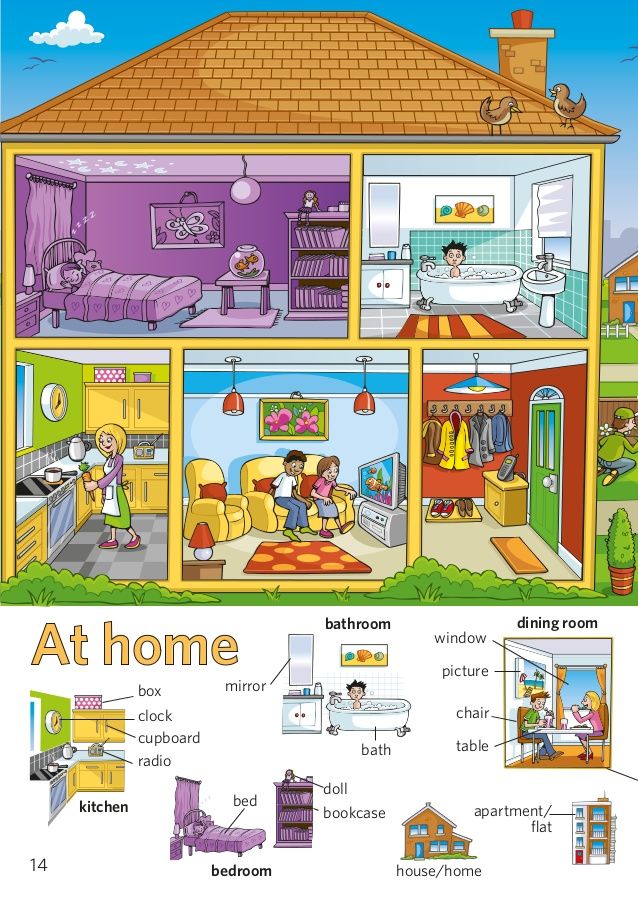
Soap — Soap can mean hand soap, which is usually foaming (bubbly) stuff in a container that you can use to wash your hands at the sink. It can also mean a bar of soap you use to clean yourself in the bath or shower.
Washcloth — A small cloth for cleaning yourself in the bath or shower.
English Bedroom Vocabulary
Bedroom Furniture and Fixtures
Bed — A mattress (the soft surface where you sleep) in a bed frame (which holds the mattress).
A bed can also just be a mattress on the floor.
Closet — A small room where you can hang clothes.
Dresser — A piece of furniture with drawers where you keep folded clothes.
Wardrobe — A tall piece of furniture with doors that you hang clothes inside.
Bedroom Items
Comforter/quilt/bedspread — A covering that goes on the top of a bed.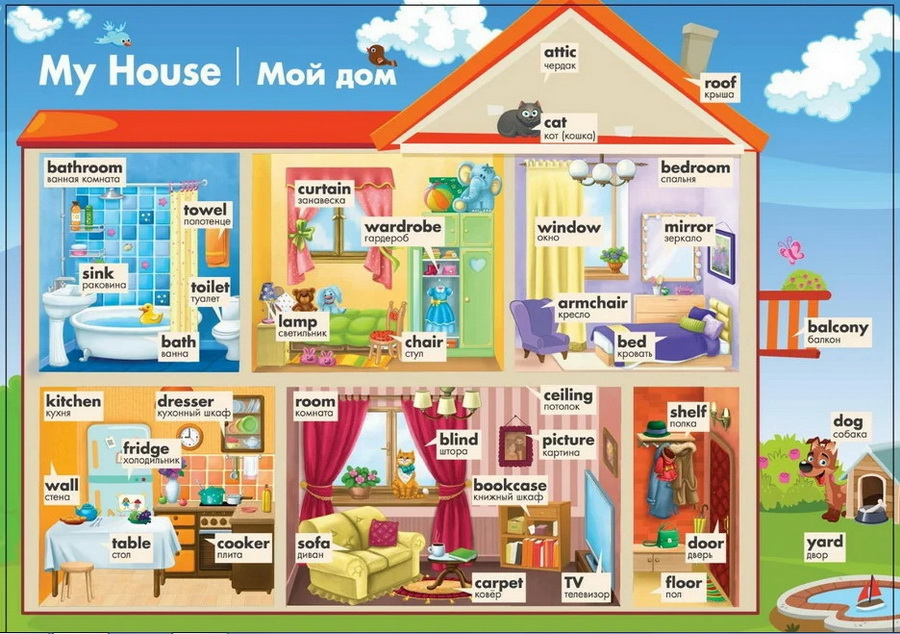
Comforters, quilts and bedspreads are all a little different, but a lot of people don’t know the difference!
Lamp — Any light with a lightbulb and cord that plugs into the wall.
Lamps usually sit on furniture or the floor.
Pillow — A pillow on a bed is usually where you put your head when you sleep.
You might also see throw pillows on a bed or elsewhere. These are more for decoration and making areas comfortable.
Sheets — The thin coverings that go over the mattress, but under the top covering (bedspread, quilt, etc.).
A fitted sheet stretches over a mattress, and a top sheet covers a person sleeping in a bed.
English Den or Living Room Vocabulary
Den or Living Room Furniture and Fixtures
Armchair — A large, stuffed chair that has arms, or raised areas where you can rest your arms.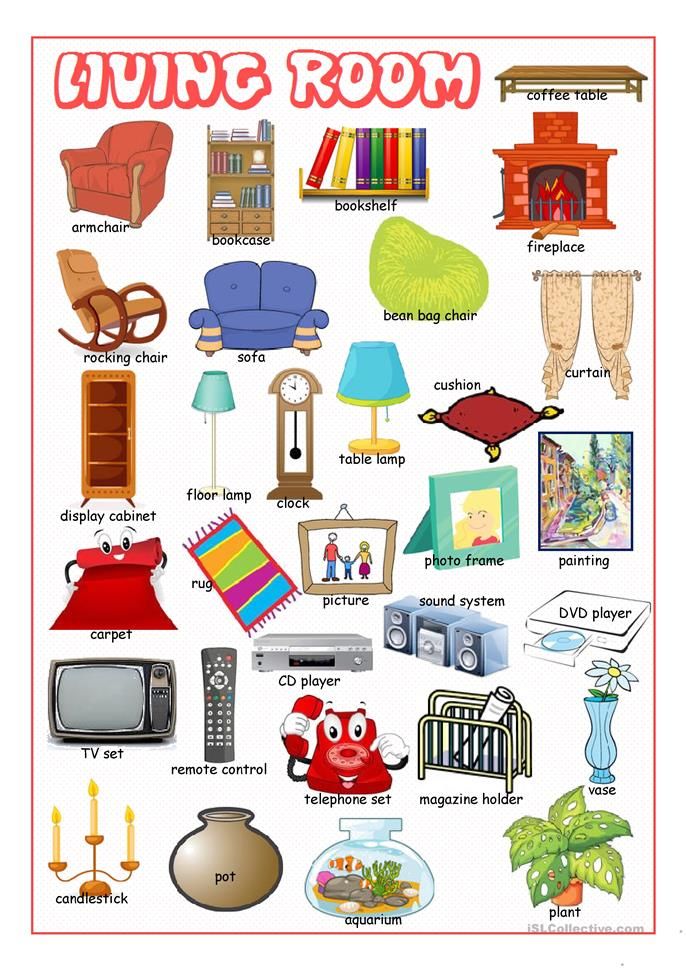
Coffee table — A low table, usually placed in front of a couch.
You can put your coffee (or another drink) here. You might also keep newspapers, magazines and a TV remote here.
Couch — A long, stuffed piece of furniture with arms. Some people might call a couch a sofa.
Side/end table — A side table, or end table, is a table meant to sit next to a couch or an armchair. Like with a coffee table, you can place drinks or other items here.
Den or Living Room Items
Television/TV — Television or TV can refer to the device with the screen you use to watch movies or shows. It can also refer to TV shows in a larger way.
For example, you might say to your friend, “Hey, can we go over to your house and watch TV?” and your friend might say, “Actually, no, because my TV is broken.”
TV remote/remote control — The controller for the TV that lets you turn it off or on and change channels.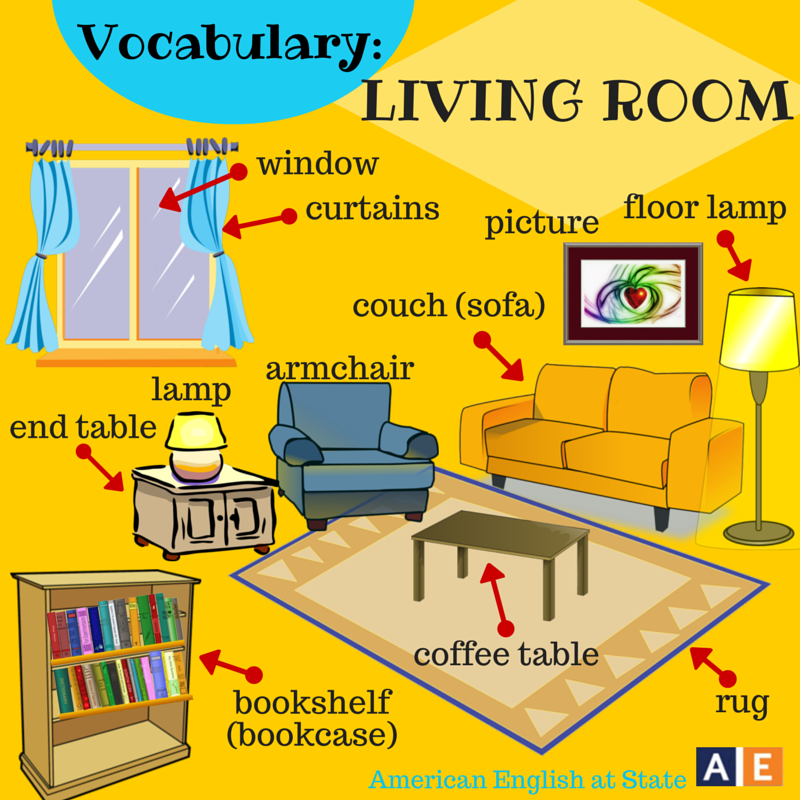
Rug — A soft, decorative covering that goes on the floor.
You might find a rug anywhere in a house, but they’re often in dens and living rooms.
Carpet and rug can mean the same thing, but usually carpet means a covering for the whole floor, while a rug is smaller (and might go on top of a carpet).
English Dining Room Vocabulary
A dining room is normally a room that you only eat in—usually, you don’t really do anything else in this room.
Dining Room Furniture and Fixtures
Dining room table — A table meant for eating, usually large enough to fit chairs for at least four people.
Dining Room Items
Cups — Any drinking container made of anything except clear (see-through) glass.
For example, coffee cups or tea cups.
Dish — A dish can be almost any kind of item that you eat food off of or serve food on.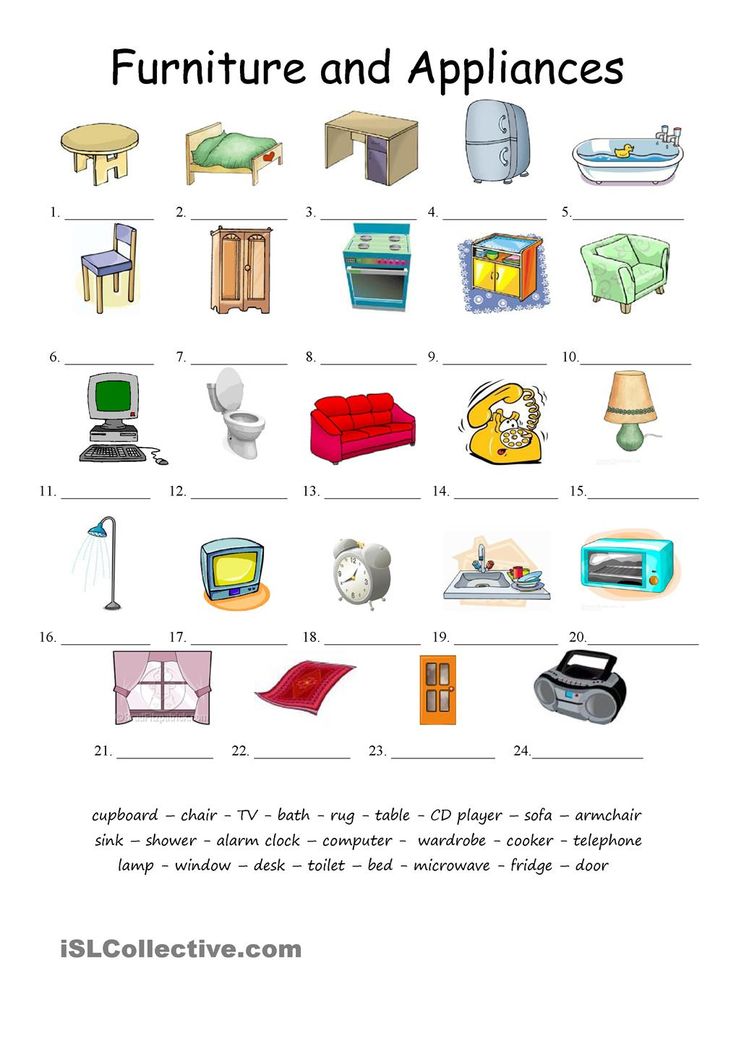
A plate is a flat dish, while bowl is only used to refer to a deep dish for holding soups or stews.
Glass — Any kind of drinking container made of glass.
Napkin — A cloth that you place on your lap while eating or use to wipe your mouth.
Silverware — Utensils (tools) for eating, including forks, spoons and knives.
Silverware might also be called cutlery or flatware.
English Kitchen Vocabulary
Kitchen Furniture and Fixtures
Cabinets — Cabinets are the storage spaces with doors you find in a kitchen, where you might keep food and cooking equipment.
Floor — Every room in a house has a floor that you walk on, because if it didn’t you’d fall into the room below!
But you might talk about the kitchen floor the most, because it usually needs to be cleaned more than other floors.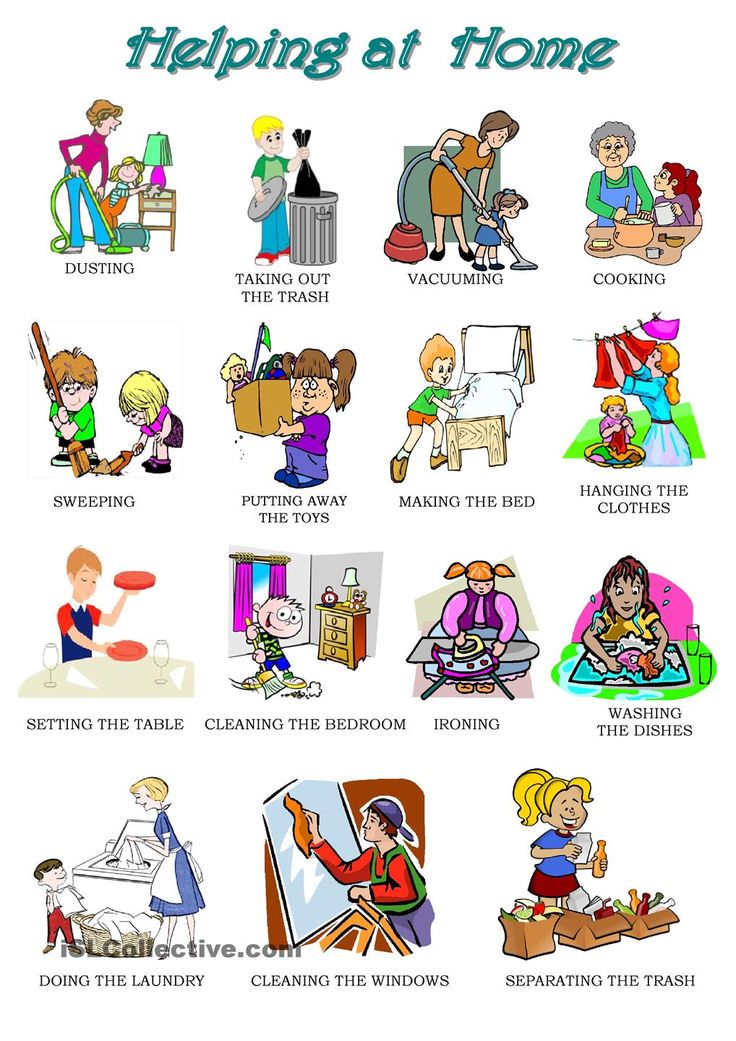
Oven — The closed space used for baking (making foods like bread by heating them inside an oven).
In most kitchens, the oven is found under the stove.
Pantry — A pantry can be a larger cabinet or a whole separate room or closet. It’s wherever you keep your non-perishables, or food that doesn’t go bad easily and doesn’t need to be kept cold.
You might also keep seasonings, spices and other flavorings in your pantry.
Refrigerator — Food that needs to be kept cold is stored in the refrigerator.
Most refrigerators have an attached freezer for keeping food frozen.
Stove — The surface you use for cooking or heating food.
Kitchen Items
Coffeemaker — There are lots of ways to make coffee, but a coffeemaker is the machine you plug in that makes your coffee by dripping it through a filter.
Kettle — A kettle is used for heating water, usually for tea.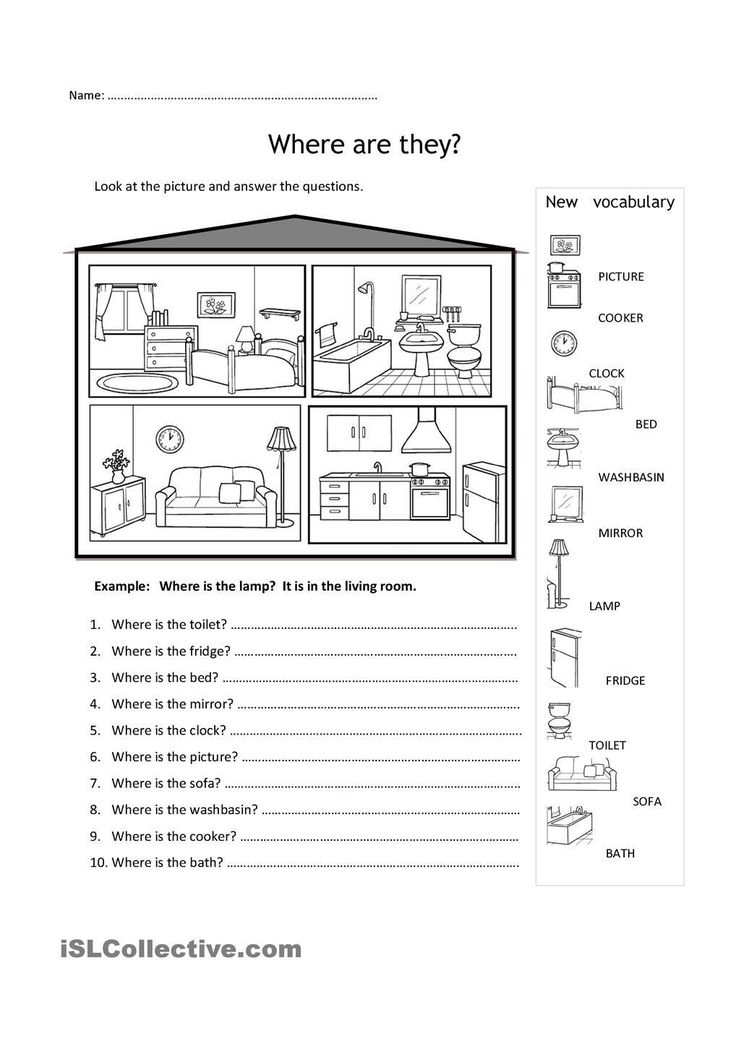
This can refer to an electric kettle, which you plug in, or a stovetop kettle, which you use to heat water on the stove.
A kettle is different from a teapot, which is where you make the tea once the water is ready.
Microwave — A small oven that heats food really fast!
You can say microwave or microwave oven.
Pots and pans — A pan can also be called a skillet, and is used for frying things on the stove, like eggs. A pot is a deeper metal container used for heating food on the stove. A saucepan is deep like a pot, but usually has a handle that sticks out.
A lot of people don’t know the difference between a pot and a saucepan, so it’s not that important.
Toaster — A toaster is a machine with slots (small open spaces) for toasting bread.
This is different from a toaster oven, which is really just a small oven you can plug in on your kitchen counter.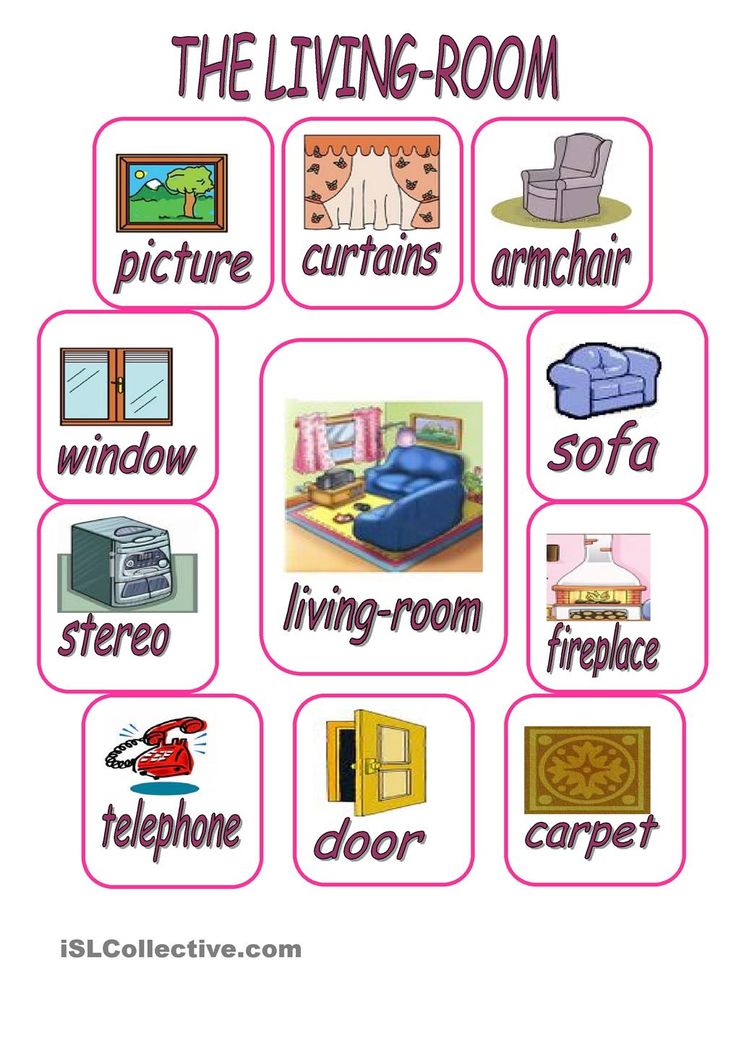
This vocabulary only covers a few of the possible rooms and items you might find in a house, but learning it is a great start!
To memorize these words quickly, you should use them as often as you can. Try to immerse yourself in English and make the language part of your daily life. Pretend like you’re living in an English-speaking country, where you’d call all your house items by their English names and you are surrounded by English content.
You can look out for house vocabulary in English media, like movies and podcasts. Immersion language learning programs can also help. One example is FluentU, which uses English videos made for and by native speakers. Each clip has tools like interactive subtitles and quizzes, so that you can understand English vocabulary and how they’re used in context.
The more you make yourself use English for everyday matters like house furniture, the faster you can improve your English skills.
And there’s no place like home to start building your fluency!
Download: This blog post is available as a convenient and portable PDF that you can take anywhere.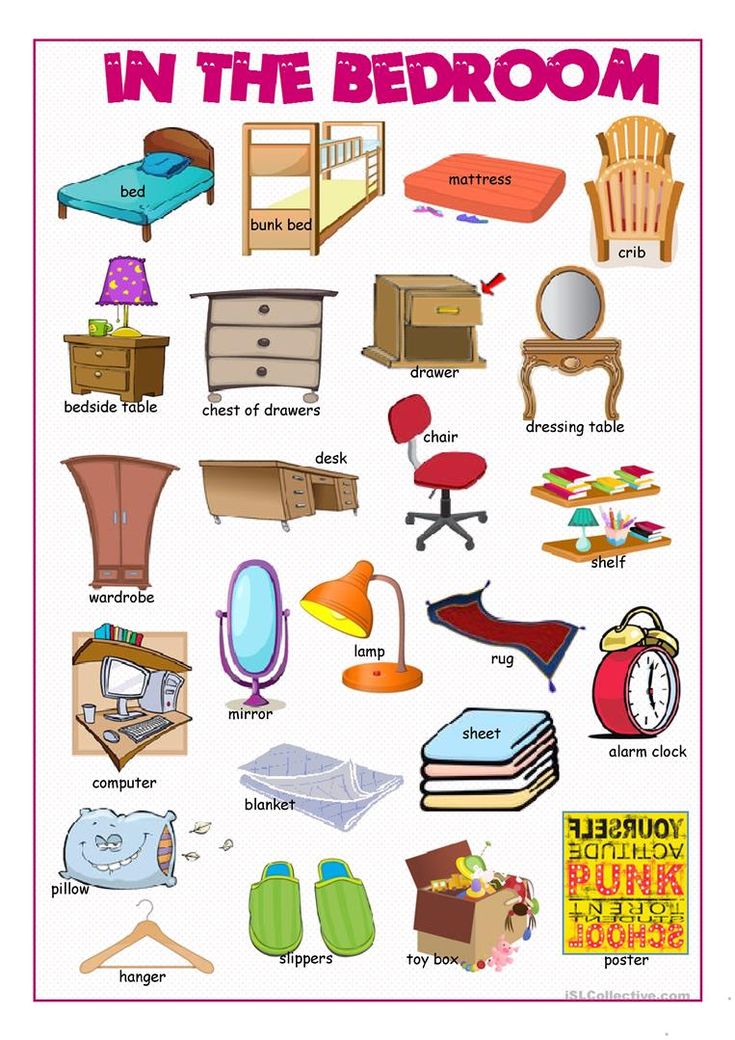 Click here to get a copy. (Download)
Click here to get a copy. (Download)
Elisabeth Cook
Elisabeth Cook is a writer, blogger and translator. You can read her blog at litallover.com.
« Saying Sorry in English: Essential Phrases for Perfect English Apologies
17 American Proverbs That Are as American as Apple Pie »
English Vocabulary - Home (Rooms and Objects)
Vocabulary - Home (Rooms and Objects)
This is a list of vocabulary items related to home
Rooms and Places in the Home
Bedroom
A room used for sleeping in.
Living room (UK also sitting room, AUSTRALIAN ENGLISH also lounge room)
The room in a house or apartment that is used for relaxing, and entertaining guests, but not usually for eating.
Bathroom
A room with a bath and/or shower and often a toilet.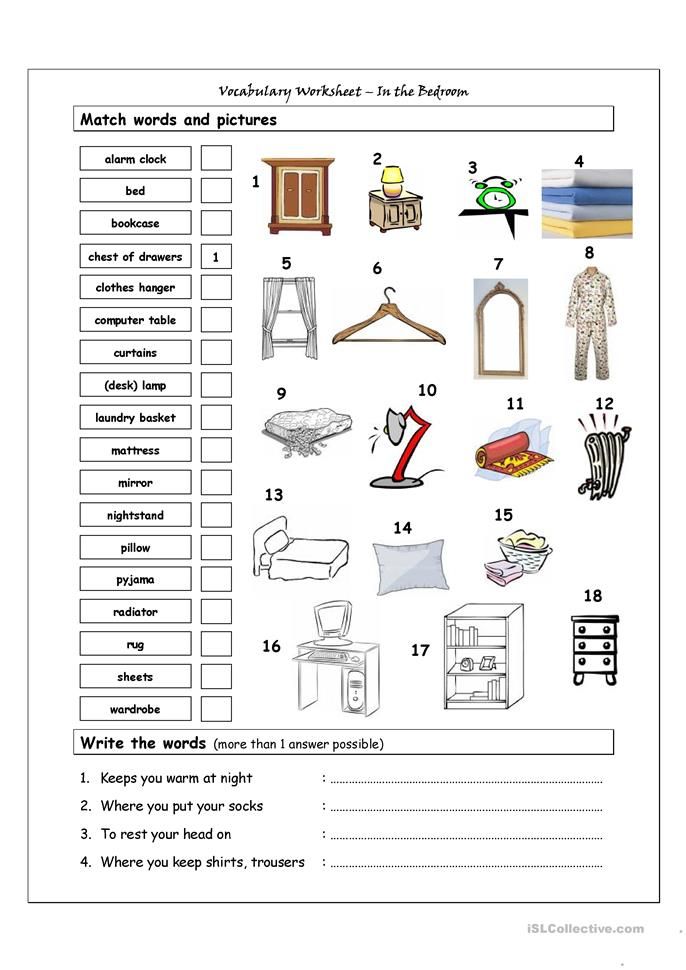
Hall
The area just inside the main entrance of a house, apartment or other building which leads to other rooms and usually to the stairs.
Utility room
Usually just for washing machine, freezer etc.
Shed
A separated building from the house usually for storing garden tools.
Loft
Space in the roof of the house usually used only for storage.
Attic
Room in the roof space of a house (could be lived in.)
Cellar
Room below ground level without any windows used for storage.
Basement
Room below ground level, with windows, used for living and working.
Landing
Flat area at the top of a staircase.
Hall
Open area as you come into the house.
Porch
Covered area before the entrance door.
Pantry or larder
Large cupboard used, especially in the past, for storing food.
Terrace or patio
Paved area between the house and garden for sitting and eating, etc.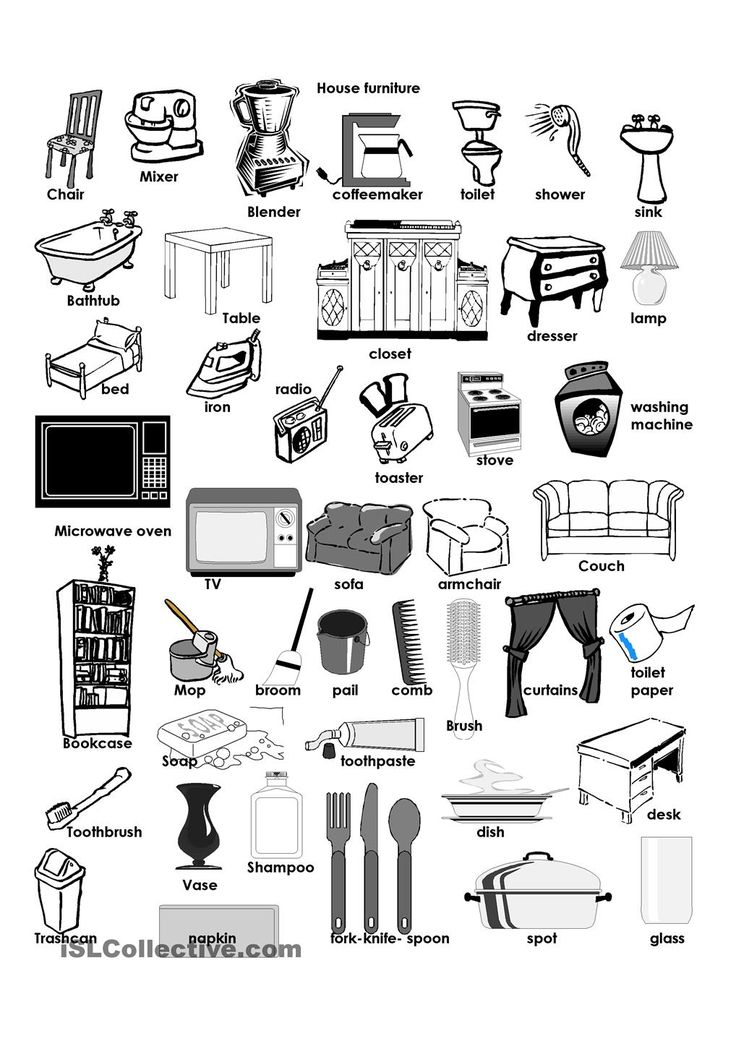
Study
A room for reading, writing, studying in.
Balcony
An area with a wall or bars around it that is joined to the outside wall of a building on an upper level.
Types of houses / Places Where People Live
House
A building which people, usually one family, live in.
Detached house
Describes a house that is not connected to any other building.
Semi detached house
A house that is semi-detached is one that is joined to another similar house on only one side.
Apartment (UK usually flat)
A set of rooms for living in, especially on one floor of a building.
Terraced house
A house that is joined to the houses on either side of it by shared walls.
Cottage
A small house, usually in the countryside.
Bungalow
A house that has only one story/floor.
Bedsit
A rented room which has a bed, table, chairs and somewhere to cook in it.
Villa
A house usually in the countryside or near the sea, particularly in southern Europe, and often one which people can rent for a holiday.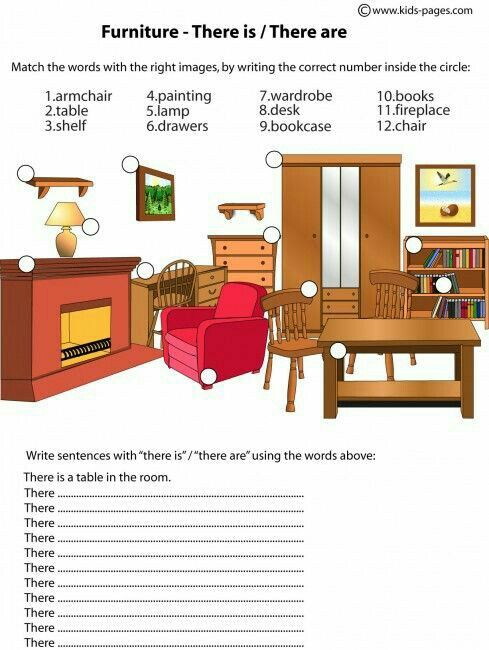
Time share
A holiday house or apartment which is owned by several different people, each of whom is able to use it for a particular period of the year.
Objects of the home
Remote control | Power point | Plug |
Television | Armchair | Chair |
Dining table | Door | Door handle |
Table mat | Wardrobe | Bed |
Bedside table | Mirror | Carpet |
Curtain | Drawer | Cupboard |
Towel | Bookshelf | Vase |
Home vocabulary exercise.
Awesome Links You May Like
12 ways to expand your vocabulary and start speaking beautifully
September 2, 2022 Education
"Just reading more" won't help.
You can listen to the article. If it's more convenient for you, turn on the podcast.
1. Get rid of parasitic words
Make room for new expressions. Eliminate “uh”, “well”, “how to”, “this is the most” and the like, as well as obscene language and clichés, from your speech. Send overly capacious expressions to them, like “real”, “fuck” and “cool”. nine0003
The trouble with them is that they can replace a significant part of the lexicon and make speech poor.
Notice unwanted words behind you. Record your own speech on a camera or voice recorder, imagine that you are at an interview or presentation. Reread your social media posts.
Analyze all this and write down the words and expressions that you want to get rid of.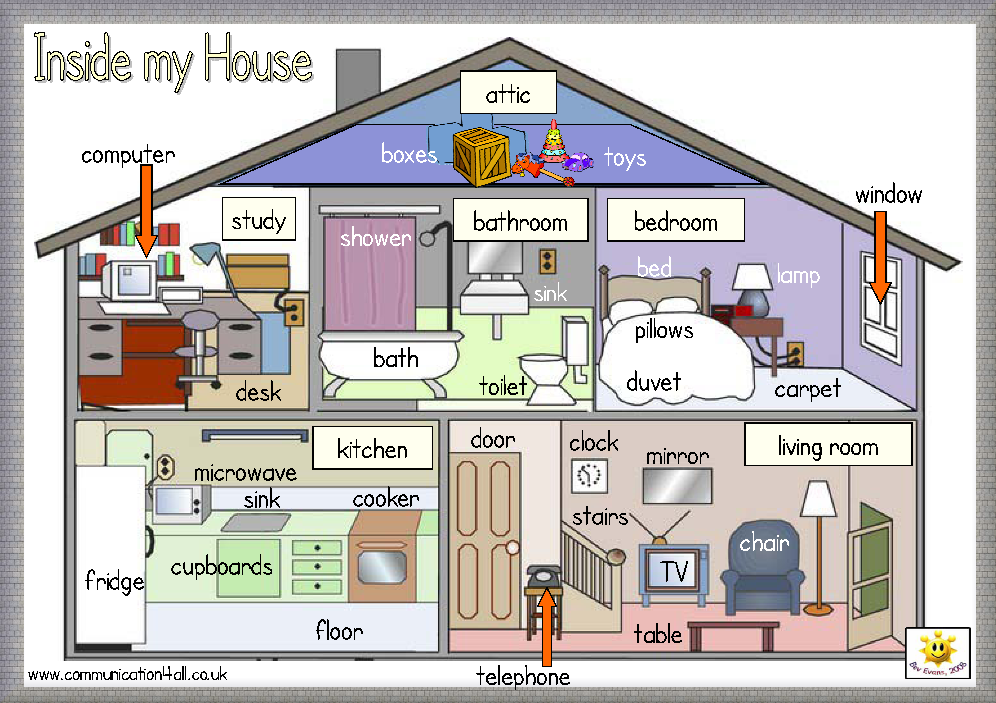 Share this list with a friend or colleague, ask him to pull you up every time he hears forbidden vocabulary. nine0003
Share this list with a friend or colleague, ask him to pull you up every time he hears forbidden vocabulary. nine0003
2. Add variety to your reading
Logically, in order to know more words, you need to read more. But do not cling only to high literature. Flip through low-brow novels, scroll through social media posts, blogs from people you don't know, and magazines that don't suit your interests.
You should know equally well what "indifferent", "emancipation" and "simulacrum" means and what "hype", "crowdfunding" and "punchline" are.
3. Learn the meaning of unknown words
Do not be lazy to look into the dictionary and do not hesitate to ask the interlocutor if you do not understand what he is talking about. There is no shame in confessing your ignorance. This is better than pretending to understand everything, continuing an unproductive conversation and losing the chance to learn something new.
4. Communicate with people who are different from you
Your usual social circle is constantly “cooked” in the same lexicon, because you have the same interests and topics for discussion.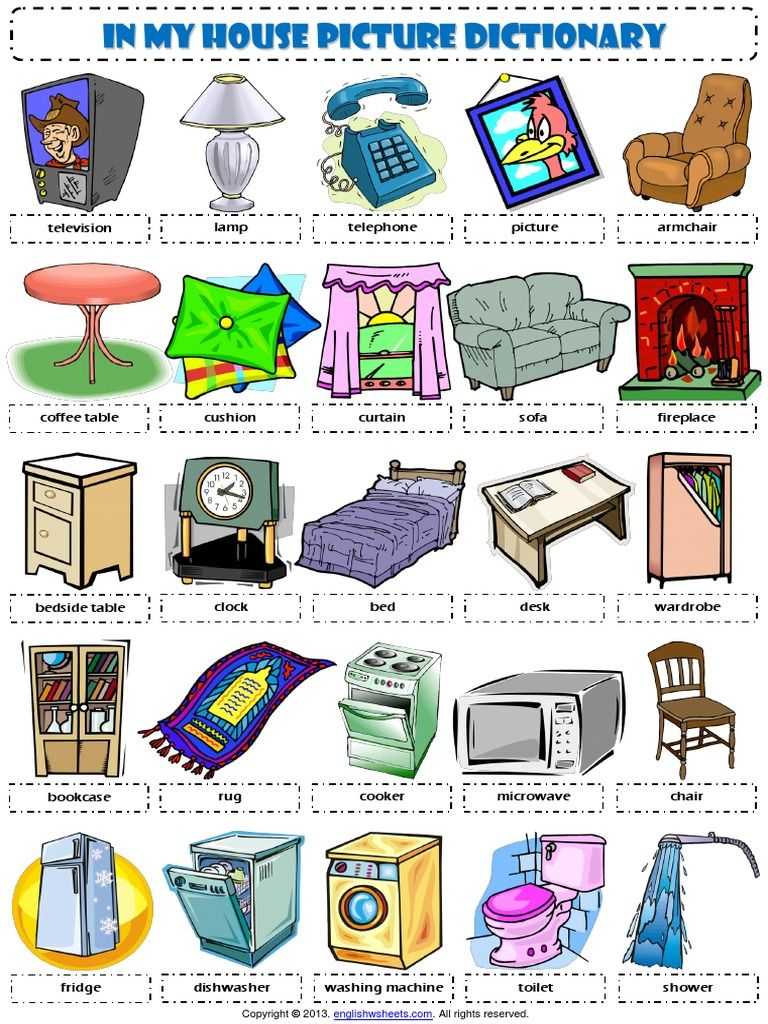 You have probably noticed that when someone from your company finds another job or meets new people, his speech changes. He sprinkles with unusual words, jokes, and even the manner of speaking can become completely different. nine0003
You have probably noticed that when someone from your company finds another job or meets new people, his speech changes. He sprinkles with unusual words, jokes, and even the manner of speaking can become completely different. nine0003
Every new person changes you. Therefore, strive to constantly expand the circle of your acquaintances. Chat at the gym, shop, go to more events, and connect online. Don't push away those who are different from you.
5. Carry a notebook with you
In it, do not hesitate to note interesting words that you come across and unwanted expressions that you notice in yourself. But just taking notes is not enough - review them regularly and draw conclusions. nine0003
6. Learn a foreign language
This will make you pay attention to your mother tongue. You will become more careful with grammar and syntax, you will begin to carefully select words.
In addition, while studying a foreign language, you are already practicing the mechanism of memorizing new words, as well as introducing them into the active vocabulary.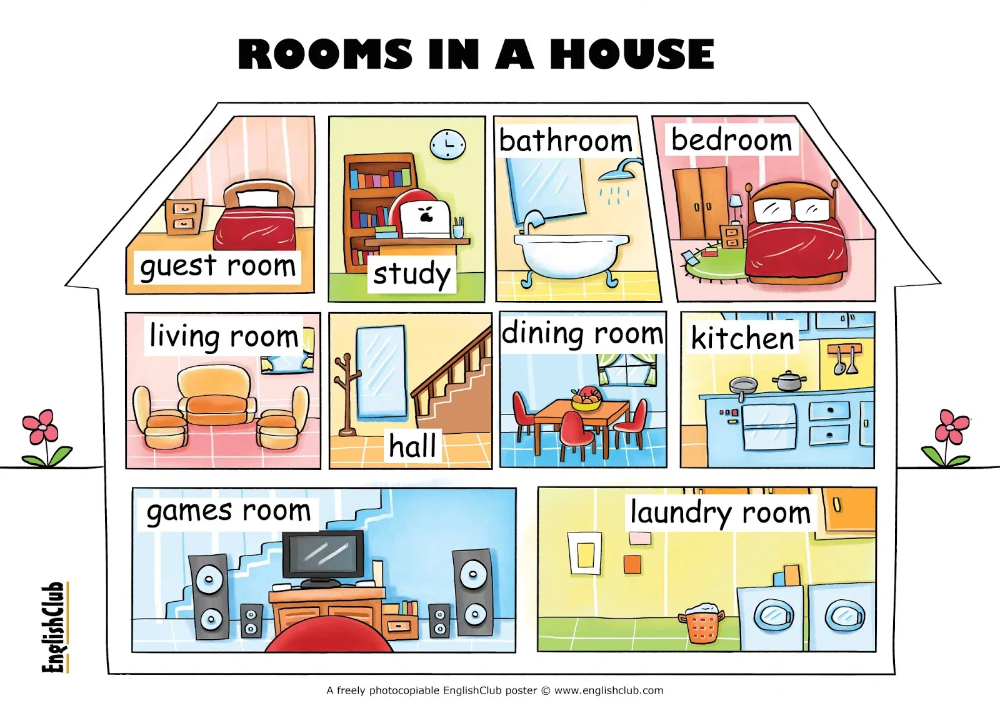
7. Write
Start a personal diary or blog on social networks. Every day, describe your thoughts and events in great detail. Write about your goals and desires, invent stories and stories. When chatting with friends, avoid broken messages and do not use emoji instead of words. nine0003
First, writing is a great way to apply and reinforce what you have learned. Secondly, if you write by hand, it will help you remember new words even better.
8. Memorize aphorisms, poems, quotes
It is much more pleasant to learn catchphrases that touched the soul than to memorize vocabulary items one by one. Mark and write down everything that is hooked. Learn, repeat and reread. Over time, there will be more interesting expressions in your vocabulary.
It's not just about embellishing speech. Imagine how great it will be to show off your knowledge in a conversation. Just do not be zealous with quotes and high-flown lines: you may be mistaken for an upstart.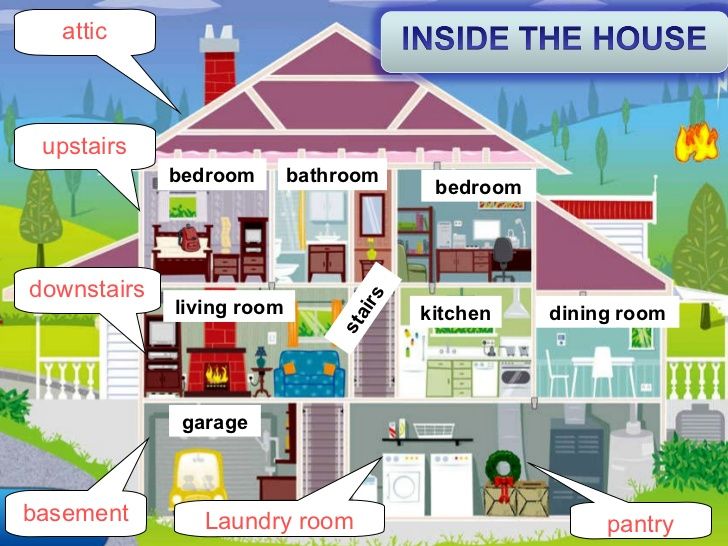 nine0003
nine0003
9. Use flashcards
If you can't remember a very difficult and interesting word, use the flashcard method. Many people know this method from school.
On one side of the card you write the word, on the other side you write its meaning. First you need to try to remember the answer yourself, and then turn the element over and check yourself.
This method is very simple and effective: the memorization process begins with preparation. Therefore, it is better not to use applications, but to create cards yourself and write on them by hand. Yes, and you can take a small pile with you anywhere. nine0003
10. Practice
- Make sentences where each word starts with the next letter of the alphabet. For example: “The stork was a great harmonica player. Even the raccoons howled plaintively and nodded their curious muzzles, enjoying the charming songs. That skill became fatal, fatal. The gloomy heron ambitiously threw poison at the frail, selfish youth.
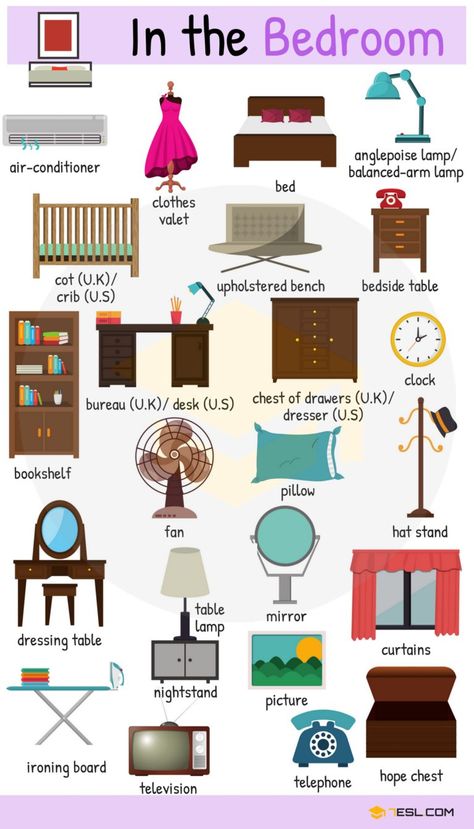
- Make up stories from words that belong to the same part of speech. Describe your morning using only nouns. “Call, wake up, alarm clock, turn off. Rise, search, clothes. Approach, window, opening, freshness. Cheerfulness, inspiration, joy. By the same principle, make up stories with only verbs, adjectives or participles. This activity seems simple only at first: if you set yourself the goal of adding more and more details, you will have to learn how to carefully select words and pull them out of the passive vocabulary. nine0072
- Compose tautograms. This is the name of the sentences, all words of which begin with the same letter. Here is an example from Nikolai Kultyapov's Olgin Ostrov: Onuphry's father, Osip Ostromirovich Ordynsky, graduated from Oxford full-time. He unequivocally refused to remain far from the Fatherland, going back. The obsessed Ordynsky announced a survey of individual districts, regions, vast outskirts.
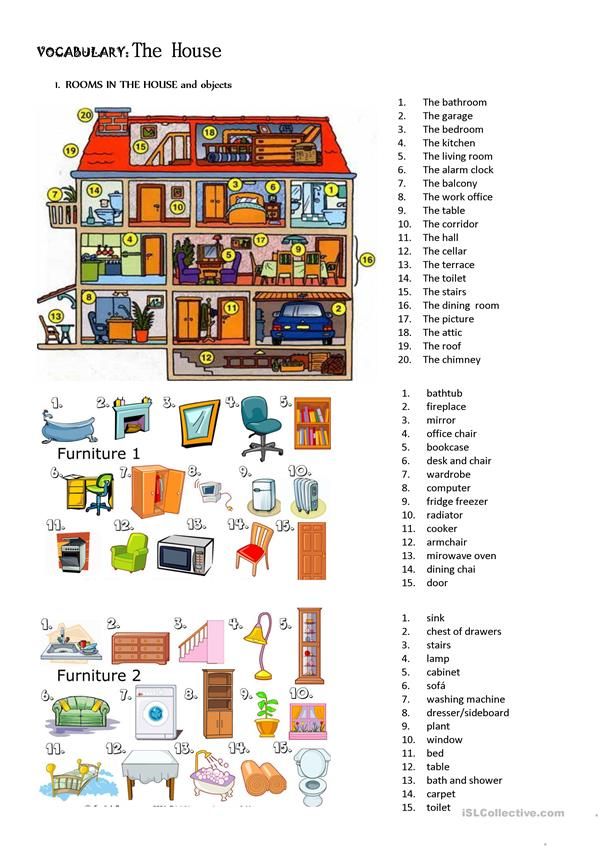
- Choose synonyms and antonyms for words. nine0071 This exercise can be done anywhere and anytime. Bored in line or at lunch - come up with a synonym for the word. For example, “beautiful” is picturesque, wonderful, gratifying, beautiful, and so on. Do the same with antonyms.
11. Play
You can learn new words while having fun. Solve puzzles, solve puzzles and crossword puzzles - it's practically a vacation. Apart from the hard work of the brain, of course.
12. Follow the "Word of the Day"
Install applications like "Word of the Day" on your smartphone, subscribe to relevant blogs and mailing lists. As a rule, in such headings, complex and unusual lexemes are presented with an explanation and an example of use. nine0003
This will help if you can't find the time to look up new interesting words and their meanings. All you have to do is learn them and put them into practice.
Read also 🧐
- How to change your speech to sound more confident
- 20 words that even literate people spell wrong
- 10 expressions that don't belong in your vocabulary
5 vocabulary exercises
Skip to content
|
How pleasant it is to listen to eloquent and competent speech when a person knows how to choose the right words and accurately describe his thought.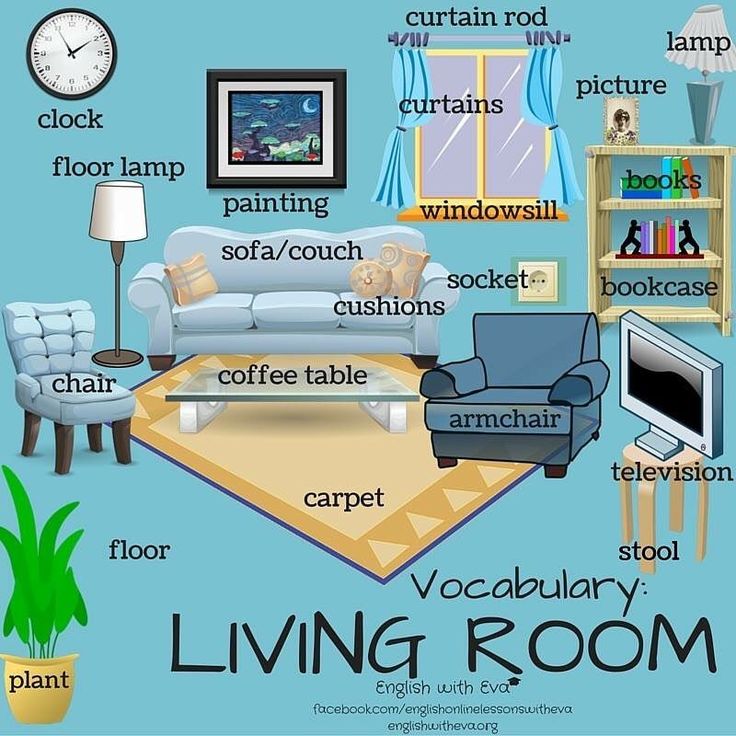 And illiterate, “poor” speech, which is quite difficult to understand, cuts the ear just as much. It is a large vocabulary that is a sign of intellectual development and can help you in learning, working or speaking in front of a large audience. nine0003
And illiterate, “poor” speech, which is quite difficult to understand, cuts the ear just as much. It is a large vocabulary that is a sign of intellectual development and can help you in learning, working or speaking in front of a large audience. nine0003
Before starting the study of exercises to increase vocabulary, let's look at the types of vocabulary:
- Active vocabulary. These are the words that we use in everyday life when communicating with friends, family, colleagues. When writing letters, SMS in chat, social networks. When we speak, we do not think about the words and do not put effort into constructing sentences.
- Passive vocabulary. These are words that we know, but do not use in conversation. As a rule, the passive reserve can be 2-3 times greater than the active one. On occasion, we can search in our head and find the right words, but we do this very rarely. nine0072
- External vocabulary. These are words we don't know. Usually these are specific words from the professional field of activity.
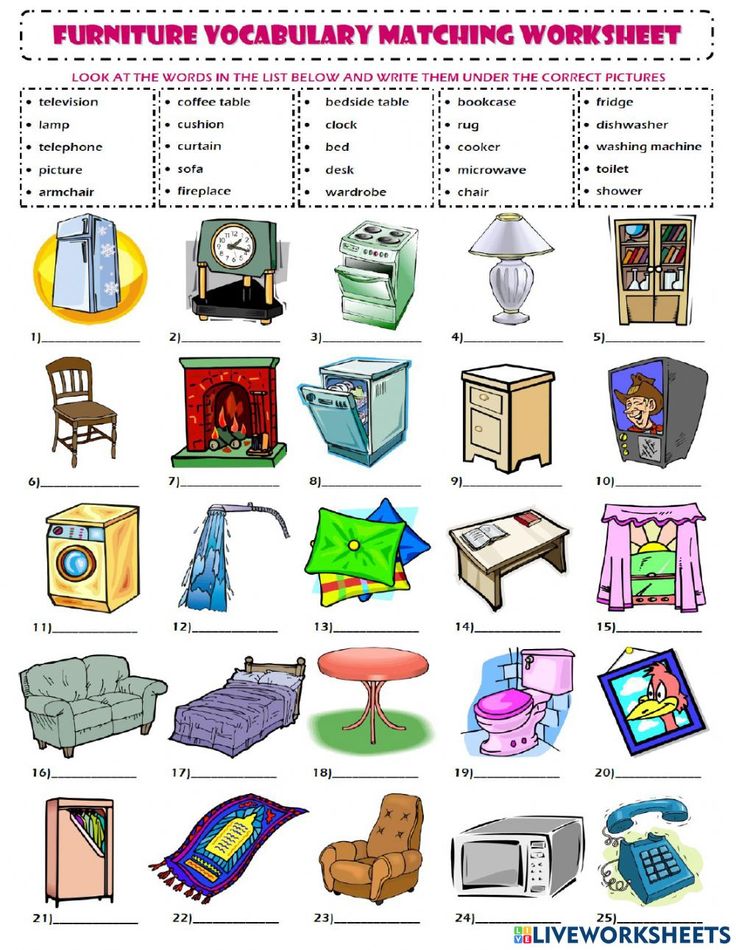
It is rather difficult to set clear boundaries in the vocabulary. Children's vocabulary can average 1000 words, adults have 10 times more. Erudite people who are constantly engaged in self-development, read a lot of books and constantly study, have a vocabulary of up to 50,000 words. Therefore, we have selected such universal exercises to expand the active vocabulary that schoolchildren, students or specialists can perform. nine0003
- Alphabet exercise. You need to come up with a sentence in which all words will begin with the next letter of the alphabet. Example: "Alina runs in the thick of trees." Try to make long sentences using words from A to Z.
- Exercise "Noun". Make up a story and tell it using only nouns. "Morning. Water. Walk. Dog. Tea. Breakfast. Metro. Job. Meeting. Tasks. Dinner."
- Exercise "Verbs". Repeat the previous exercise, only using verbs instead of nouns. nine0072
- Exercise "Adjectives and adverbs". Also invent a story, just voice it now with the help of adjectives and adverbs.


